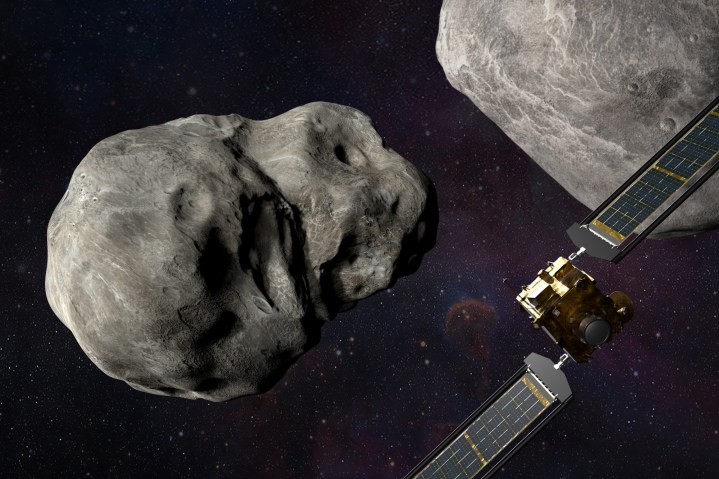In 2022, the world watched with fascination as NASA deliberately crashed a spacecraft into an asteroid in a test of what kind of defense options might be available to humanity if an incoming asteroid ever threatened Earth. Observers could tell very quickly that the test, called the Double Asteroid Redirection Test or DART, was successful in changing the asteroid’s orbit. But now astronomers have learned more, finding that the impact may have reshaped the asteroid significantly.
The asteroid impacted, called Dimorphos, is very small at around 500 feet across, and the DART spacecraft crashed into it at a tremendous speed of nearly 4 miles per second. Researchers have now used computer modeling to see the effects of this impact, given the limited amount of information we have on the composition and uneven surface of Dimorphos.

The results have been interpreted into an animation, showing material being thrown off during the impact and the squished shape that is thought to remain. You can view the animation on the European Space Agency’s website.
Modelling the impact required a lot of computer power due to the many unknown factors at work. “This is a computationally intensive process, with each simulation taking around a week and a half to run, and we ran around 250 simulations overall, reproducing the first two hours after impact,” lead author Sabina Raducan of the University of Bern said in a statement.
“We incorporated all the values we did know – such as the mass of the DART spacecraft, the approximate shape of the asteroid, the orbital deflection and the size of the impact plume – while varying the factors we don’t know, such as the closeness of packing of boulders, their density, the porosity of material and its overall cohesion. We also made some reasonable assumptions based on the physical properties of meteorites resembling Dimorphos.”
The researchers took the results of their many simulations and looked for the one that mostly closely matched the data from the real test. They found that Dimorphos was likely deformed because it is not a single, solid mass but rather a collection of smaller pieces held together by gravity, called a rubble pile. That helped the DART spacecraft to cause such a big impact.
The fact that the asteroid is in a low-gravity environment also makes a difference. Here on Earth, when an object impacts another hard enough to leave a crater, the material from the impact tends to be thrown up briefly before falling due to gravity. But in space, where there is less gravitational force, the displaced material (called ejecta) was thrown up in a much wider cone, causing the crater on the surface to grow.
“The likelihood is that the crater grew to encompass the entire body itself, so that Dimorphos ended up being completely reshaped,” Raducan explained. And that has consequences for future missions planning to visit the asteroid to learn more about DART’s effect, such as the European Space Agency’s Hera mission.
“As a consequence, Hera will probably not be able to find any crater left by DART. What it will discover instead will be a very different body. Our simulations suggest that Dimorphos has had its initial flying saucer shape blunted on its impact side: If you think of Dimorphos as starting out as resembling a chocolate M&M, now it would look like it has had a bite taken out of it!”
The research is published in the journal Nature Astronomy.
Editors’ Recommendations

